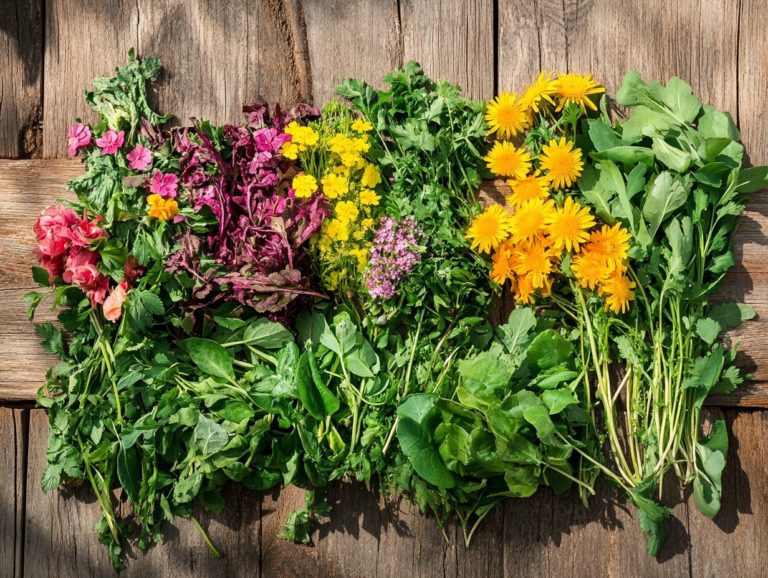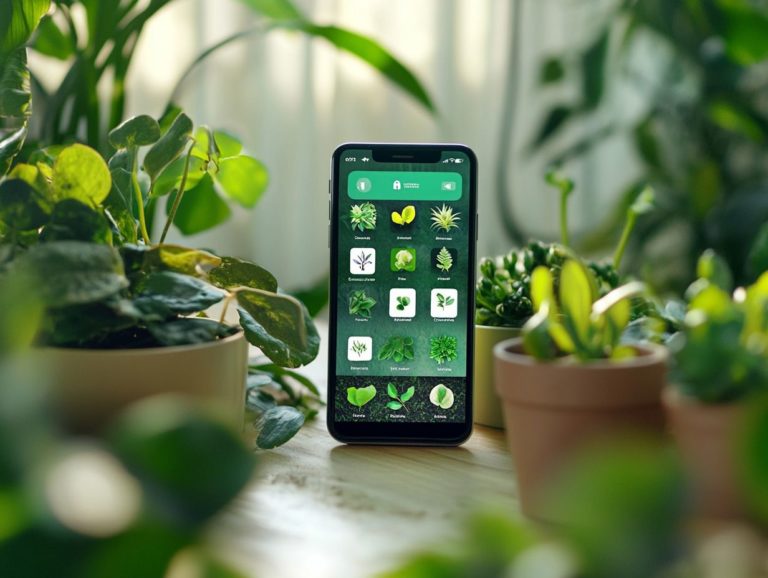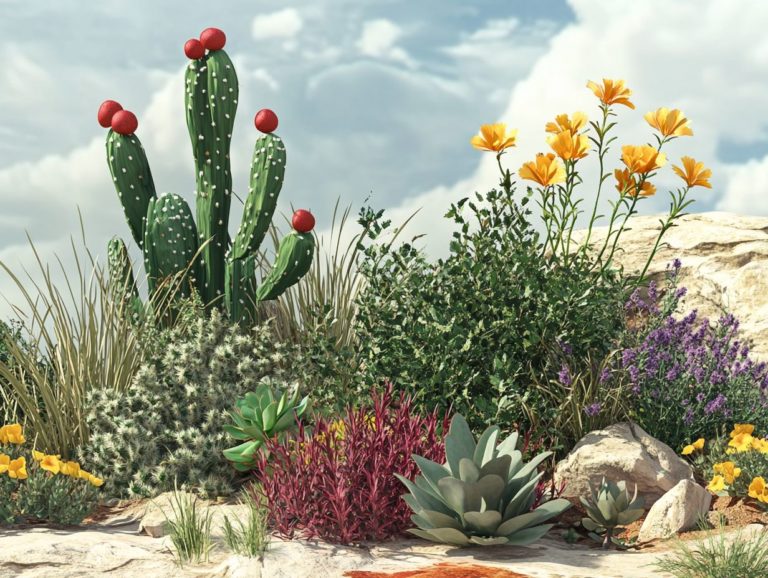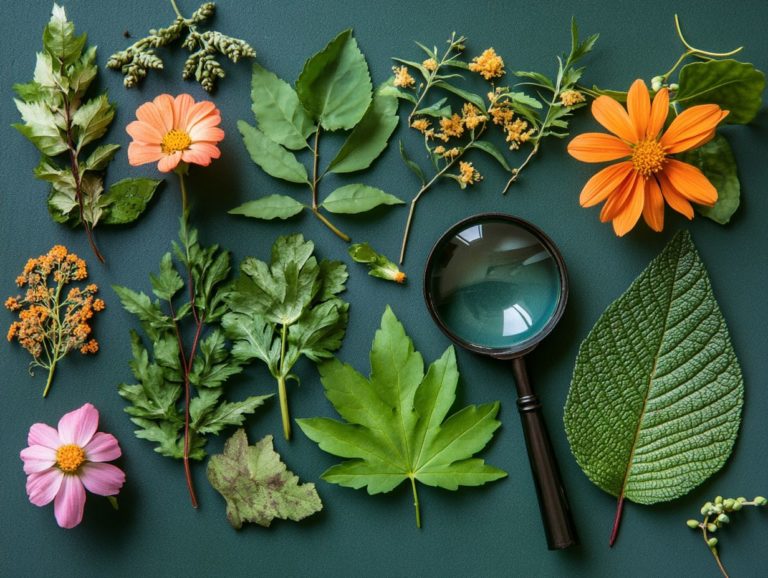Top 10 Wild Plants Everyone Should Recognize
Wild plants, including many edible varieties, are all around you, often unnoticed yet full of potential. From culinary delights to medicinal wonders, mastering the art of identifying and utilizing these plants can greatly enhance your life in unexpected ways.
This article showcases ten essential wild plants from dandelion to cattails that every forager should recognize. Delve into their uses, uncover the benefits of foraging, understand the associated risks, learn common identification mistakes, and gather tips for ethical harvesting.
Embark on this journey to uncover the hidden treasures that nature has to offer!
Contents
- Key Takeaways:
- 1. Dandelion
- 2. Stinging Nettle
- 3. Wild Garlic
- 4. Blackberry
- 5. Wild Rose
- 6. Elderflower
- 7. Chickweed
- 8. Yarrow and Other Herbal Allies
- 9. Pine Tree and Its Versatile Uses
- 10. Cattails and Their Unique Contributions
- Why Is It Important to Know These Wild Plants and Their Uses?
- What Are the Benefits of Foraging for Wild Plants and Their Nutritional Value?
- What Are the Risks of Eating Wild Plants and How to Mitigate Them?
- How Can These Wild Plants Be Used in Cooking, Medicine, and Beyond?
- What Are Some Common Mistakes Made When Identifying Wild Plants?
- How Can One Safely and Ethically Harvest Wild Plants?
- What Are Some Other Useful Wild Plants to Know?
- Frequently Asked Questions
- Curious about the top 10 wild plants you should know? Here s the list!
- Why is it important to be able to recognize these wild plants?
- How can I identify poison ivy and stinging nettle?
- What are some common uses for wild garlic and wild berries?
- Can I eat wild mushrooms?
- Are there any precautions I should take when handling these plants?
- Get Informed!
Key Takeaways:
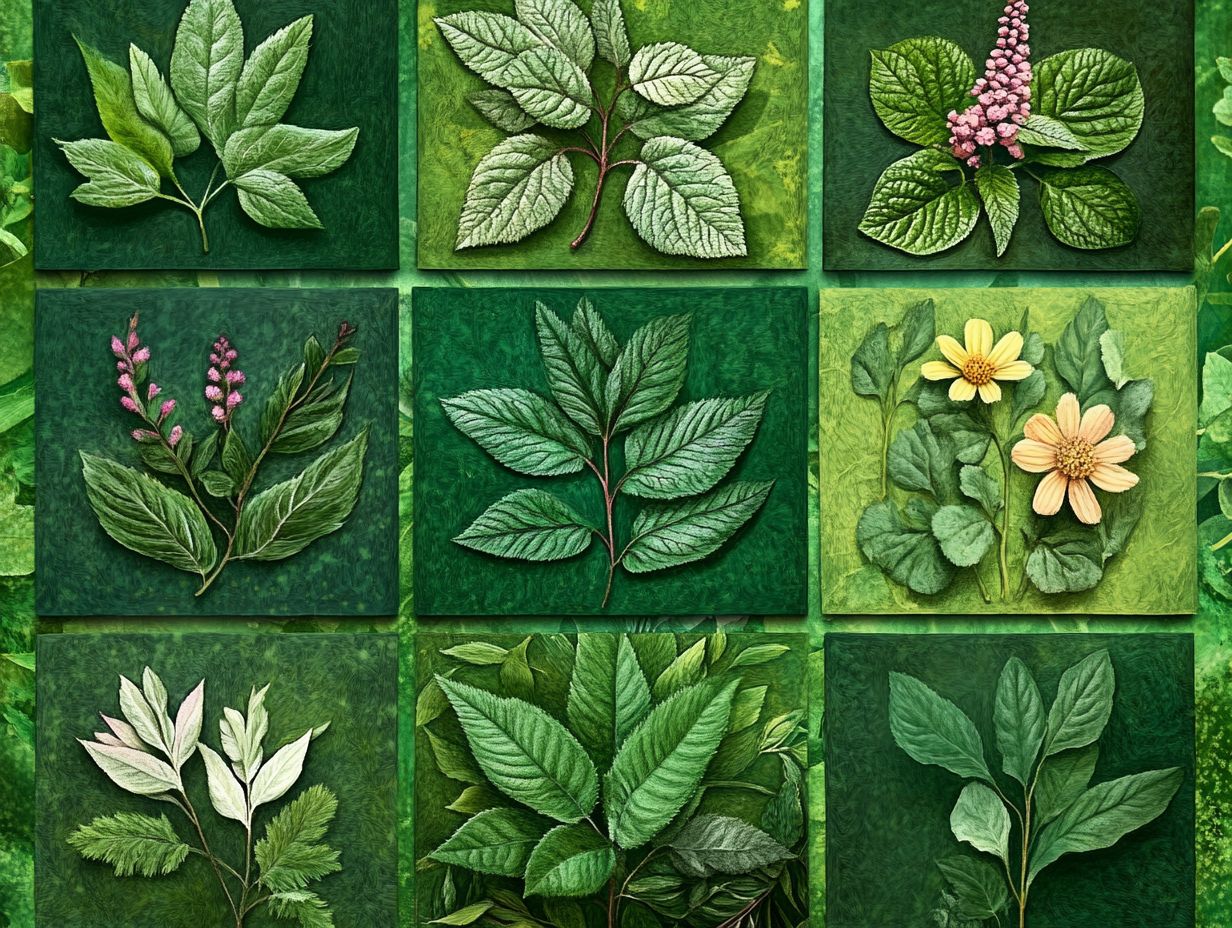
- Dandelions are more than just pesky weeds; they are packed with nutrients and can be used in salads, teas, and even as a coffee substitute.
- Stinging nettles may hurt at first touch, but they have many health benefits and can be used in soups, pesto, and as a natural dye.
- Wild garlic not only adds delicious flavor to dishes, but it also has antibacterial properties and can be used in medicine.
1. Dandelion
Imagine transforming wild weeds into delicious dishes! Dandelions are not just vibrant wild plants; they re hidden gems brimming with nutritional and medicinal benefits.
You ll find them to be staples in both foraging and herbal medicine practices. These adaptable edible plants thrive in various environments, from gardens to meadows, showcasing their remarkable resilience.
Rich in vitamins and minerals, dandelions often go unnoticed yet play a vital role in survival skills and natural healing, especially in regions like Western Washington and Northern Latitudes. Every part of the dandelion plant is edible, offering a delightful array of flavors and health advantages.
Enjoy the young, tender leaves fresh in salads or saut ed as a nutritious side dish. The bright yellow flowers can be transformed into delightful teas or infused oils, elevating your culinary creations.
Roasted dandelion roots provide a rich, earthy flavor that serves as a perfect coffee substitute. Known for detoxifying properties, these plants support liver health and digestion, making them invaluable in herbal medicine.
For those keen on foraging, identifying dandelions is easy just look for the distinct jagged leaves and bright flowers on slender stems, typically blooming from early spring to late summer. Incorporating dandelions into your meals boosts nutrition and adds a touch of wild, foraged flavor to your dishes.
2. Stinging Nettle
Stinging nettle, often encountered in the wild, is a remarkable edible plant that is great for cooking and offers impressive medicinal benefits. This wild plant can enhance your soups, teas, and serve as a nutritious green.
Its medicinal properties have been celebrated in herbal medicine for centuries, particularly if you know how to identify it in areas like Western Washington and Northern Latitudes. To safely enjoy stinging nettle, you’ll need to neutralize its sting through cooking, drying, or steeping.
This process transforms those sharp edges into a delightful, nutrient-dense ingredient. Its culinary applications are extensive; think of blending it into pesto, folding it into omelets, or brewing it into herbal infusions that promote overall wellness.
Stinging nettle also has anti-inflammatory effects and is often used as a natural remedy for conditions like arthritis. Identification is crucial, as it can resemble other plants; look for serrated leaves, square stems, and dark green coloration.
Properly recognizing this plant allows you to reap its full benefits while steering clear of potential look-alikes. Ready to start foraging? Let’s dive into the first plant!
3. Wild Garlic
Wild garlic is a delightful wild edible plant that enhances your culinary creations with its robust flavor. It also offers a wealth of health benefits, making it a prized ingredient for herbal medicine.
You ll often find wild garlic thriving in lush environments, easily identifiable by its distinctive aroma and broad leaves. For anyone with a passion for plant identification and foraging, this herb is essential.
Its uses extend well beyond the kitchen; it boasts a variety of medicinal properties that can support your overall health.
This remarkable herb often grows in damp woodlands and alongside streams, where it showcases clusters of small, star-shaped white flowers, adding to its charm.
In your recipes, it can shine fresh in pestos, infuse oils with its flavor, or serve as an aromatic addition to soups and salads.
Beyond its culinary allure, wild garlic is packed with antioxidants substances that help protect your body from damage and allicin, known for its anti-inflammatory properties. This makes it a valuable ally in traditional remedies for ailments like colds and digestive issues.
Don’t miss out on the thrill of a foraging adventure! Remember to harvest responsibly. Take only a few leaves from each plant to ensure their sustainable growth and preserve the delicate ecosystem they thrive in.
This mindful practice not only benefits the environment but also enriches your foraging experience, allowing you to connect with nature in a meaningful way.
4. Blackberry
Get ready to discover why blackberries are a favorite among foragers! These nutrient-rich berries offer a delightful balance of sweetness and tang that captivates culinary enthusiasts.
Not only are they a staple for survival skills in wilderness settings, but they also come packed with a wealth of nutritional advantages. Their impressive antioxidant content means that indulging in blackberries delivers not just a tasty treat but also numerous health benefits.
Typically, you ll find blackberries thriving in sunny, well-drained areas, where they form dense brambles in thickets and along roadsides.
In the kitchen, these versatile fruits shine in jams, pies, and smoothies, providing a burst of flavor that elevates both sweet and savory dishes.
Rich in vitamins C and K, as well as fiber, consuming blackberries supports your immune health and promotes digestive well-being.
For those adventurous enough to forage in the wild, it s essential to practice sustainable gathering methods. Leave plenty of berries for wildlife and avoid overharvesting to ensure these delectable plants continue to flourish for generations to come.
5. Wild Rose
Wild roses are truly enchanting plants that enhance your surroundings while offering a treasure trove of edible parts and remarkable medicinal benefits. They are a fantastic choice for foragers and herbalists alike.
Their petals, hips, and leaves can be creatively utilized in a variety of culinary delights and natural remedies, demonstrating their versatility in both flavor and health enhancement.
By understanding how to identify and use these plants, you can deepen your appreciation for these native beauties found in regions like Western Washington and beyond.
Imagine infusing those vibrant petals in teas or transforming them into aromatic syrups that add a delicate floral note to your desserts.
Meanwhile, the rose hips the fruit of the wild rose are brimming with vitamin C and can be crafted into jams, jellies, or teas that boost your immune health. Their impressive antioxidant properties work wonders in combating inflammation and promoting skin vitality.
For those adventurous souls venturing into the wild, look for wild roses by spotting their five-petaled flowers and glossy green leaves. This will help you distinguish them from similar plants, ensuring your foraging adventure is both rewarding and delightful.
6. Elderflower
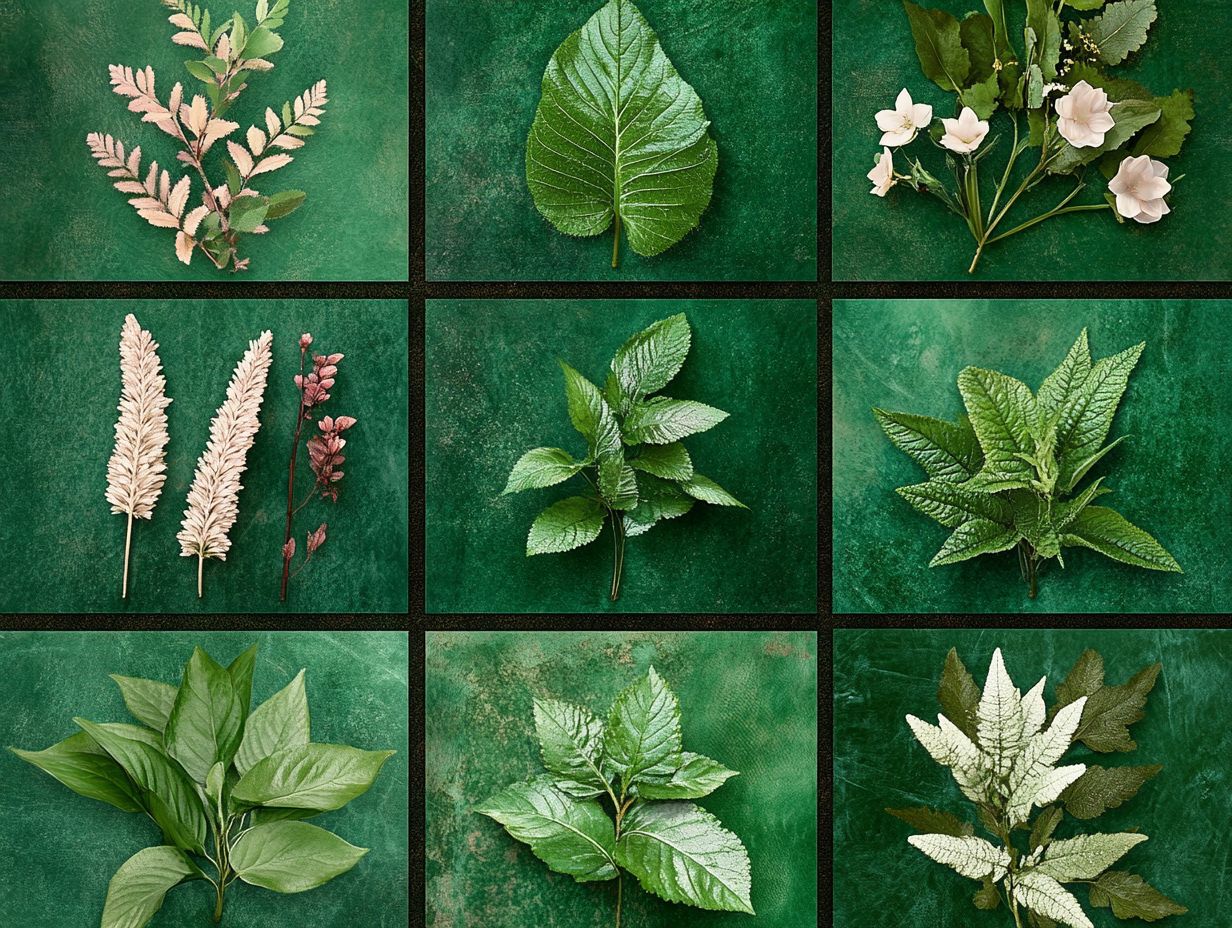
Elderflower is a fragrant wild edible plant, celebrated for its delicate blossoms and an array of culinary and medicinal uses. It s no wonder that foragers and herbal enthusiasts alike hold this gem in high regard.
This versatile flower can be transformed into syrups, teas, and other delightful creations. Its health benefits are impressive, offering natural remedies cherished for generations.
Imagine enjoying elderflower syrup in sparkling water for an unforgettable treat a refreshing way to indulge in its floral notes. Or sip on homemade elderflower tea, a comforting brew rich in antioxidants.
Beyond its cooking appeal, elderflower boasts remarkable medicinal qualities, including anti-inflammatory effects and immune-boosting properties that contribute to overall wellness. If you love the adventure of foraging, mastering plant identification techniques is crucial to safely gather elderflowers, especially in thriving regions like Western Washington and Northern Latitudes.
To ensure these beautiful plants endure for future generations, practicing sustainable harvesting is essential. By taking only a fraction of the blossoms and ensuring the health of the plants remains intact, you can help preserve this enchanting flora.
7. Chickweed
Chickweed is a remarkable wild edible plant that often flies under the radar. Yet, it brings a wealth of culinary and medicinal benefits, making it an invaluable addition to your foraging toolkit.
With its delicate, star-shaped leaves and charming small white flowers, this versatile herb can easily take center stage in your kitchen. You can use it as a garnish or elevate your dishes by incorporating it into delightful pesto, hearty soup, and savory omelets.
The subtly sweet flavor of chickweed adds a refreshing touch to salads. Plus, its impressive nutritional profile packed with vitamins A and C offers a host of essential health benefits.
Beyond its culinary uses, chickweed has earned its place in herbal medicine, known for its soothing properties. It s often utilized in poultices a soft mass applied to the skin to relieve irritation to alleviate skin irritations.
If you re keen on harvesting it sustainably, you ll be pleased to know that chickweed is easily identifiable by its creeping growth pattern and distinctive leaf arrangement. This allows you to responsibly enjoy its gifts without compromising local populations.
8. Yarrow and Other Herbal Allies
Yarrow is an extraordinary wild plant, celebrated for its medicinal benefits and various applications in herbal medicine. It s an invaluable resource for anyone interested in natural remedies and wellness practices.
With its feathery leaves and clusters of white flowers, yarrow has been a trusted ally for centuries. It treats wounds, reduces inflammation, and supports digestion, showcasing its worth far beyond mere foraging.
Proper plant identification is essential for safely incorporating yarrow into your herbal collection, especially in regions like Northern Latitudes and Western Washington.
This versatile herb can be prepared in many forms think teas, liquid extracts made from herbs, and poultices allowing you to customize its use to fit your specific needs.
Historically, yarrow has been not only a healing powerhouse but also a flavorful addition to culinary dishes, enhancing salads and other recipes with its distinct taste. Have you ever tried using yarrow as a natural remedy?
When you venture out to forage for yarrow, keep an eye out for its tall, bushy stature and jagged leaves, ideally found in sunny meadows or along roadsides. Remember, sustainable harvesting practices are vital; always take just a small portion of the plant to ensure its continued growth and availability for future generations.
9. Pine Tree and Its Versatile Uses
Pine trees stand as iconic symbols of the wilderness. They are remarkable sources of edible parts and natural remedies, making them essential for survival skills in untamed environments.
From their needles, brimming with vitamin C, to their resin and nuts, pine trees present a diverse array of plant uses that can bolster both your nutrition and health. Mastering the art of plant identification enables you, as a seeker of wild food, to tap into the full potential of these resilient trees.
The tender young shoots and pine nuts serve as vital sources of protein and healthy fats. Meanwhile, the bark can be transformed into a nutritious flour for various recipes. In terms of cooking, pine needles can impart a delightful flavor to teas and syrups, and the resin has long been valued for its antiseptic properties in natural remedies.
To identify different pine species, pay attention to the unique needle cluster formations, cone shapes, and bark textures that distinguish varieties such as the Ponderosa, Eastern White, and Lodgepole pine. This knowledge not only sharpens your foraging skills but also deepens your appreciation for the intricate ecosystem around you.
10. Cattails and Their Unique Contributions
Cattails are truly remarkable wild plants that thrive in wetlands. They offer a wealth of edible parts and essential survival skills, making them a treasure for foragers and nature enthusiasts alike.
With their tall, reed-like stature, cattails serve up a variety of food sources roots, young shoots, and even pollen positioning them as a staple in wilderness survival and natural remedies. Mastering their identification is crucial for safely harvesting these resilient plants.
You can spot these hardy plants along marshes and slow-moving waters, distinguished by their unique brown flower spikes. You ll love adding tender young shoots to your salads or stir-fries, while the starchy rhizomes (underground stems) can be boiled or roasted for a nutritious side dish.
Additionally, collecting the pollen offers a delightful twist, serving as a flour substitute that adds a distinctive flavor to your cooking. Certain parts of the cattail also have dietary benefits, having been utilized in traditional remedies to treat wounds and skin irritations.
By recognizing key features like the flat leaves and cylindrical flower spikes, you can confidently differentiate cattails from toxic look-alikes. This ensures a safe and rewarding foraging experience.
Why Is It Important to Know These Wild Plants and Their Uses?
Understanding wild plants is essential for anyone interested in survival skills, foraging, and natural remedies. These plants not only provide healthy and medicinal benefits but also offer invaluable knowledge for thriving in diverse environments.
By cultivating a deeper connection with the natural world, you can unlock the immense potential within your local ecosystems. Knowledge of wild plants enables you to identify and utilize these resources, promoting a sustainable approach to harvesting.
Acknowledging the role these plants play in nutrition-infused diets enhances your personal health and wellness. Recognizing native flora fosters ecological respect and appreciation, nurturing a stewardship mindset that encourages others to preserve and protect these invaluable natural assets.
Ultimately, embracing this wisdom allows you to adopt a holistic lifestyle that enriches both your personal survival skills and your community awareness.
What Are the Benefits of Foraging for Wild Plants and Their Nutritional Value?
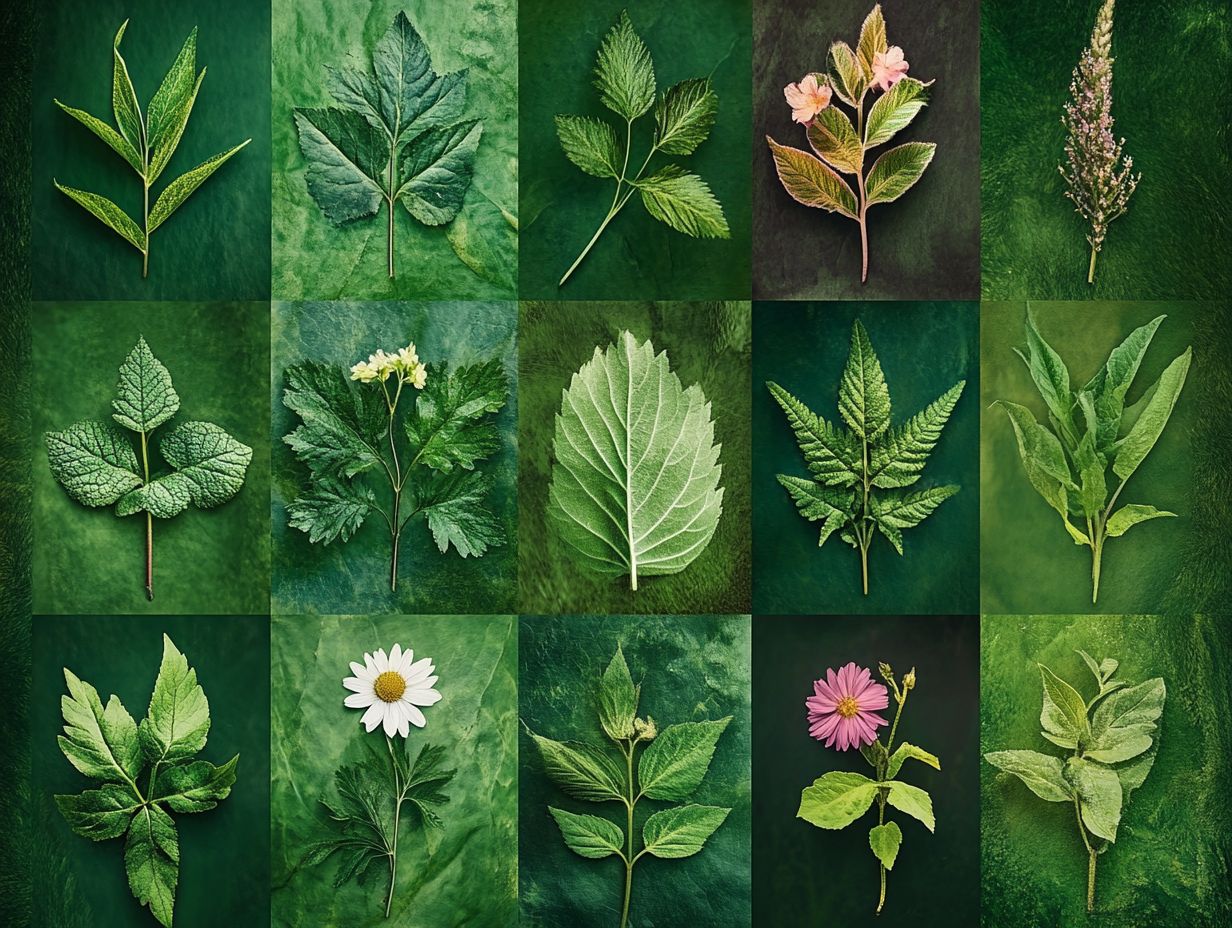
Foraging for wild plants brings a wealth of benefits. It gives you access to fresh, organic food while enhancing your cooking experiences and deepening your connection to nature.
This rewarding pursuit appeals to both enthusiasts and survivalists. It offers you a chance to engage with the natural world in a meaningful way. Incorporating nutrient-rich edible plants into your diet promotes a healthier lifestyle, nurtures your mental well-being, and cultivates an appreciation for biodiversity.
Exploring natural remedies from these wild plants expands your understanding of herbal medicine, which means using plants for health benefits, and sustainable practices. Foraging can be a communal activity. It invites individuals to explore together and share knowledge, ultimately strengthening social bonds.
As you discover new species and their uses, you ll develop skills that foster environmental stewardship and enhance your awareness of local ecosystems. Every wild plant has a story to tell! This journey enriches your life and leads to a sustainable future. By nurturing relationships with both nature and your community through foraging and herbal medicine, you gain not just food but also invaluable experiences and connections that elevate your everyday life.
What Are the Risks of Eating Wild Plants and How to Mitigate Them?
Foraging for wild plants can be a rewarding adventure, but you must recognize the risks involved! Improper identification can lead to some serious consequences.
Many wild plants have toxic look-alikes. It s essential to hone your plant identification skills to ensure safety. Some plants might even trigger allergic reactions or interact with medications. This highlights the importance of knowledge and caution as you explore the intriguing world of wild edibles, especially with species like Clover and Dandelions.
These potential risks extend beyond mere toxicity. You may also face cross-reactivity with seasonal allergens, which can be particularly challenging if you have sensitivities. Certain plants may contain compounds that interfere with medications, complicating your foraging plans even further, especially with Nut trees and their byproducts.
To navigate these hazards effectively, make sure to consult reliable resources. Check out field guides like Botany in a Day or join local foraging groups. Consider attending workshops led by seasoned foragers, including those from Wolf Camp.
Remember the golden rule: when in doubt, throw it out! This straightforward maxim emphasizes the necessity of prioritizing caution in every foraging experience, especially when navigating the diverse species of edible plants.
How Can These Wild Plants Be Used in Cooking, Medicine, and Beyond?
Wild plants present you with a world of culinary creativity and wellness. They act as a natural reservoir of flavors, nutrients, and medicinal properties. These elements can elevate both your cooking and herbal medicine practices.
Imagine the vibrant taste of wild garlic and the sweetness of blackberries, alongside the healing attributes of yarrow and stinging nettle. These plants can easily find their way into your dishes and remedies, seamlessly connecting nature with your kitchen. Mastering the art of utilizing these wild plants is crucial to tapping into their potential!
- Wild garlic adds zest to savory dishes.
- Blackberries are sweet and rich in antioxidants.
- Yarrow is known for its anti-inflammatory properties.
- Stinging nettle can be made into nutritious soups.
For example, wild garlic can transform your pasta or pesto recipes into something extraordinary. Blackberries bring delightful sweetness to your desserts and support your overall health. Yarrow can be steeped into a calming tea, while stinging nettle provides essential vitamins and minerals.
By exploring recipes that spotlight these wild ingredients, you can elevate your meals and enjoy the myriad health benefits they offer.
What Are Some Common Mistakes Made When Identifying Wild Plants?
Identifying wild plants can be a truly rewarding skill, but it s all too easy to fall into common traps that lead to misidentification and potential health risks. You might confuse edible plants with toxic look-alikes. Overlooking key identification features is a common error, as is neglecting to research the specific habitats and seasonal variations of plants.
Understanding these pitfalls is vital for anyone eager to elevate their plant identification skills and enhance their survival expertise in the wilderness.
Take, for example, the notoriously deadly hemlock, which is often mistaken for the innocent cow parsley due to their similar leafy structures. Beginners might also find themselves confusing wild garlic with lily of the valley, which is a plant that poses serious health risks.
To navigate these challenges effectively, you should document your findings with photographs and notes, paying close attention to both the plant’s characteristics and its habitat. Joining local foraging groups can provide you with invaluable insights and help you learn from seasoned foragers.
This way, you can transform the risk of misidentification into an opportunity for growth, ensuring your foraging adventures are not only safer but also more successful!
How Can One Safely and Ethically Harvest Wild Plants?
Safely and ethically harvesting wild plants is vital for preserving ecosystems and ensuring long-term sustainability. As a forager, you carry the responsibility to respect nature while relishing its offerings. This practice requires you to grasp the best harvesting techniques, identify which plants to collect, and adhere to guidelines that promote biodiversity and conservation.
By integrating these principles into your foraging practices, you can enjoy the benefits of wild plants while maintaining healthy ecosystems.
Begin by familiarizing yourself with local regulations regarding plant collection, as these laws exist to protect vulnerable species and habitats. Embrace sustainable harvesting methods by taking only what you need and avoiding over-collection in any one area. Techniques like selective cutting and encouraging regrowth not only help plants thrive but ensure that future generations can also revel in the joys of foraging.
Understanding seasonal growth patterns how plants grow during different times of the year is essential for timing your harvests appropriately, minimizing the impact on local flora. A respectful approach to harvesting enhances your foraging experience and deepens your connection to the natural world.
What Are Some Other Useful Wild Plants to Know?
Plus the previously mentioned wild plants, you’ll uncover an exciting variety of other useful wild plants that can elevate your foraging skills, enhance your cooking, and enrich your herbal medicine practices, deepening your understanding of nature s bounty.
From nutrient-dense greens like purslane and chicory to medicinal herbs such as milk thistle and wild comfrey, familiarizing yourself with these plants can unlock a treasure trove of culinary and health benefits. Engaging with comprehensive plant guides will not only enhance your knowledge of the top 10 plants but also lead you to many more.
Consider dandelion, for instance. Not only does it lend a delightful bitterness to salads, but it also promotes liver health. Then there’s stinging nettle, packed with iron and vitamins, which can be brewed into invigorating teas or tossed into soups. Identifying these plants becomes a breeze with their distinctive serrated leaves and tall, stinging stems.
Another remarkable choice is lamb’s quarters, often referred to as ‘wild spinach’ for its versatility in various dishes. Meanwhile, red clover, with its sweet blooms, can be foraged for herbal infusions and is said to support respiratory health.
Dive into these plants and deepen your bond with nature while enjoying delicious culinary and medicinal delights!
Check out this informative video for more insights on wild plants!
Frequently Asked Questions
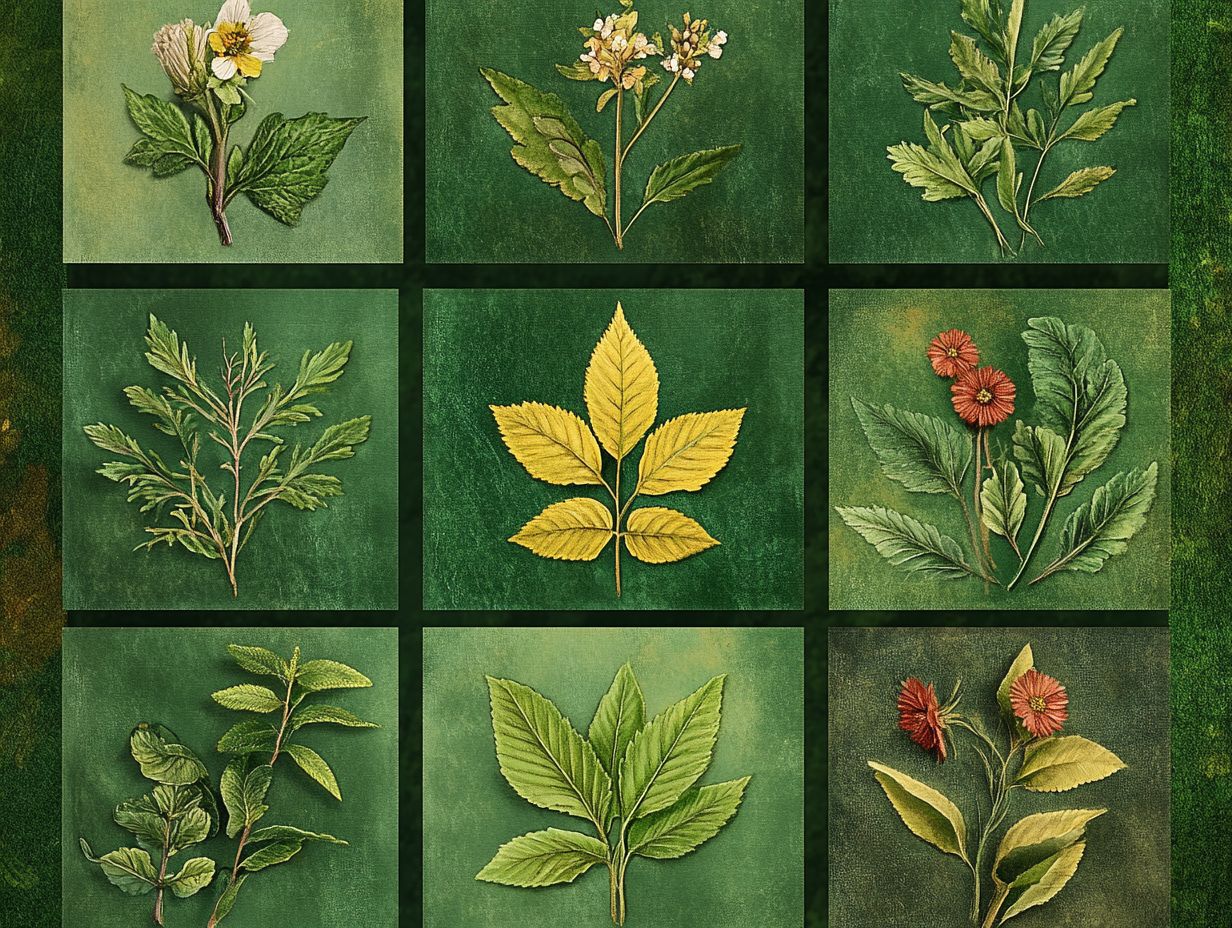
Curious about the top 10 wild plants you should know? Here s the list!
The top 10 wild plants everyone should recognize are: poison ivy, stinging nettle, wild garlic, wild berries, dandelion, daisy, wild mushrooms, chamomile, yarrow, and cattail. For those new to foraging, the top 5 wild edibles for beginners can be a great starting point.
Why is it important to be able to recognize these wild plants?
Recognizing wild plants is crucial. Some may harm you, while others can be useful for medicine or food.
How can I identify poison ivy and stinging nettle?
Poison ivy has three pointed leaves that cause a red, itchy rash. Stinging nettle has serrated leaves with tiny hairs that sting when touched.
What are some common uses for wild garlic and wild berries?
Wild garlic makes a great seasoning for cooking. Wild berries can be a tasty snack, or you can use them in pies and jams.
Can I eat wild mushrooms?
Leave wild mushrooms alone unless you’re a pro! Some could be deadly.
Are there any precautions I should take when handling these plants?
Always wear gloves and long sleeves when handling these plants. Afterward, wash your hands thoroughly to avoid irritation.
Get Informed!
Knowing about wild plants keeps you safe and opens up a world of culinary adventure. Start your journey today!

